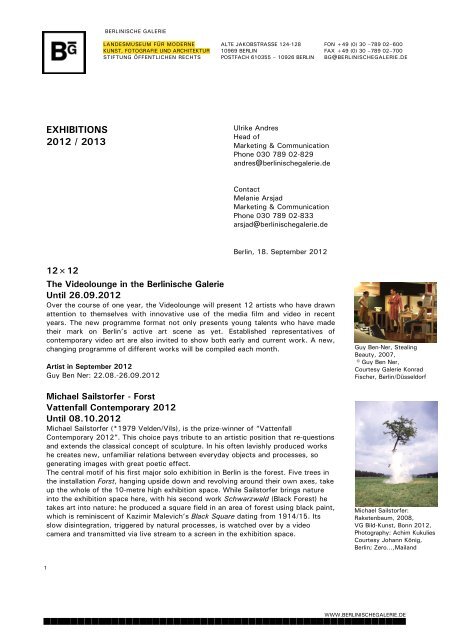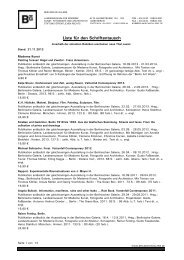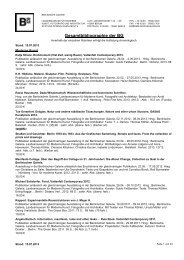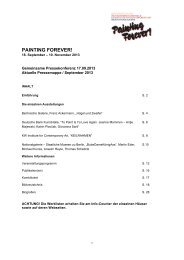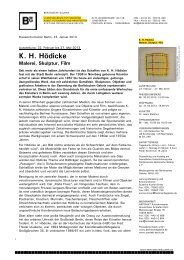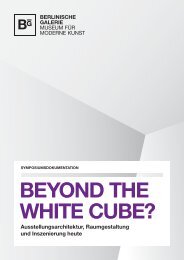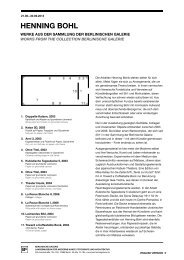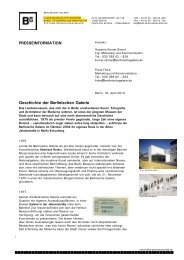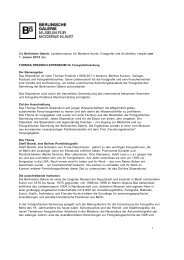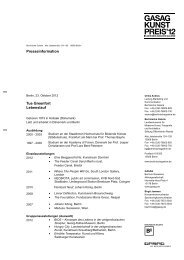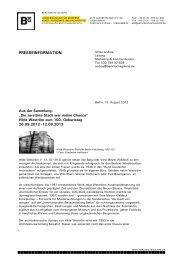EXHIBITIONS 2012 / 2013 - Berlinische Galerie
EXHIBITIONS 2012 / 2013 - Berlinische Galerie
EXHIBITIONS 2012 / 2013 - Berlinische Galerie
Create successful ePaper yourself
Turn your PDF publications into a flip-book with our unique Google optimized e-Paper software.
<strong>EXHIBITIONS</strong><br />
<strong>2012</strong> / <strong>2013</strong><br />
1<br />
12×12<br />
BERLINISCHE GALERIE<br />
LANDESMUSEUM FÜR MODERNE ALTE JAKOBSTRASSE 124-128 FON +49 (0) 30 –789 02–600<br />
KUNST, FOTOGRAFIE UND ARCHITEKTUR 10969 BERLIN FAX +49 (0) 30 –789 02–700<br />
STIFTUNG ÖFFENTLICHEN RECHTS POSTFACH 610355 – 10926 BERLIN BG@BERLINISCHEGALERIE.DE<br />
Ulrike Andres<br />
Head of<br />
Marketing & Communication<br />
Phone 030 789 02-829<br />
andres@berlinischegalerie.de<br />
Contact<br />
Melanie Arsjad<br />
Marketing & Communication<br />
Phone 030 789 02-833<br />
arsjad@berlinischegalerie.de<br />
Berlin, 18. September <strong>2012</strong><br />
The Videolounge in the <strong>Berlinische</strong> <strong>Galerie</strong><br />
Until 26.09.<strong>2012</strong><br />
Over the course of one year, the Videolounge will present 12 artists who have drawn<br />
attention to themselves with innovative use of the media film and video in recent<br />
years. The new programme format not only presents young talents who have made<br />
their mark on Berlin’s active art scene as yet. Established representatives of<br />
contemporary video art are also invited to show both early and current work. A new,<br />
changing programme of different works will be compiled each month.<br />
Artist in September <strong>2012</strong><br />
Guy Ben Ner: 22.08.-26.09.<strong>2012</strong><br />
Michael Sailstorfer - Forst<br />
Vattenfall Contemporary <strong>2012</strong><br />
Until 08.10.<strong>2012</strong><br />
Michael Sailstorfer (*1979 Velden/Vils), is the prize-winner of “Vattenfall<br />
Contemporary <strong>2012</strong>”. This choice pays tribute to an artistic position that re-questions<br />
and extends the classical concept of sculpture. In his often lavishly produced works<br />
he creates new, unfamiliar relations between everyday objects and processes, so<br />
generating images with great poetic effect.<br />
The central motif of his first major solo exhibition in Berlin is the forest. Five trees in<br />
the installation Forst, hanging upside down and revolving around their own axes, take<br />
up the whole of the 10-metre high exhibition space. While Sailstorfer brings nature<br />
into the exhibition space here, with his second work Schwarzwald (Black Forest) he<br />
takes art into nature: he produced a square field in an area of forest using black paint,<br />
which is reminiscent of Kazimir Malevich’s Black Square dating from 1914/15. Its<br />
slow disintegration, triggered by natural processes, is watched over by a video<br />
camera and transmitted via live stream to a screen in the exhibition space.<br />
Guy Ben-Ner, Stealing<br />
Beauty, 2007,<br />
© Guy Ben Ner,<br />
Courtesy <strong>Galerie</strong> Konrad<br />
Fischer, Berlin/Düsseldorf<br />
Michael Sailstorfer:<br />
Raketenbaum, 2008,<br />
VG Bild-Kunst, Bonn <strong>2012</strong>,<br />
Photography: Achim Kukulies<br />
Courtesy Johann König,<br />
Berlin; Zero…,Mailand<br />
WWW.BERLINISCHEGALERIE.DE<br />
������������������������������������������������������
Sailstorfer studied under Olaf Metzel at the Academy of Fine Arts in Munich and at<br />
Goldsmiths College in London. To date, it has been possible to see solo exhibitions of<br />
his work in the Schirn Kunsthalle Frankfurt a. M. (2008), the Kestner Society<br />
Hanover (2010/11), the S.M.A.K. in Genth (2011), and Kunsthalle Nuremberg<br />
(2011).<br />
The members of the jury for Vattenfall Contemporary were: Magnus af Petersen,<br />
Head of Exhibitions and Collections, Moderna Museet, Stockholm; Angela Bulloch,<br />
prizewinner of Vattenfall Contemporary 2011; Udo Bekker, Board member HR,<br />
Vattenfall Europe AG; Hanna Marie Ebert, Manager of Corporate Art – Vattenfall<br />
Collection; Dr. Thomas Köhler, Director of the <strong>Berlinische</strong> <strong>Galerie</strong>; Dr. Heinz Stahlhut,<br />
Head of the Fine Art Collection, <strong>Berlinische</strong> <strong>Galerie</strong><br />
The Shuttered Society<br />
Artistic Photography in the GDR 1949-1989<br />
05.10.<strong>2012</strong>–28.01.<strong>2013</strong><br />
Press conference: 4.10. at 11 am, opening 4.10. at 7 pm<br />
The <strong>Berlinische</strong> <strong>Galerie</strong> is putting together the first exhibition in the world to take a<br />
comprehensive look at art photography in the GDR. Key questions will be: Was art<br />
photography ever free under authoritarian East German conditions? And how did<br />
things change over the course of four decades? The museum will show works by 33<br />
photographers that critically reflect social conditions: Ursula Arnold’s blunt<br />
descriptions of everyday life, Arno Fischer’s melancholy symbolic images, Jens<br />
Rötzsch’s colourful metaphors of a society falling apart, and the purely subjective,<br />
emotional compositions to be found in work by Thomas Florschuetz and Maria<br />
Sewcz. The positions selected convey the major threads of development in art<br />
photography in the GDR: montage and experimentation, documentary perspectives<br />
and social reportage, and the work of young newcomers in the 1980s.<br />
Artists: Ursula Arnold, Tina Bara, Sibylle Bergemann, Christian Borchert, Micha<br />
Brendel, Kurt Buchwald, Lutz Dammbeck, Klaus Elle, Arno Fischer, Thomas<br />
Florschuetz, Ernst Goldberg, Klaus Hähner-Springmühl, Matthias Hoch, Edmund<br />
Kesting, Jörg Knöfel, Fritz Kühn, Matthias Leupold, Ulrich Lindner, Karl Heinz Mai,<br />
Sven Marquardt, Roger Melis, Florian Merkel, Peter Oehlmann, Helga Paris, Manfred<br />
Paul, Richard Peter sen., Evelyn Richter, Jens Rötzsch, Rudolf Schäfer, Michael<br />
Scheffer, Erasmus Schröter, Gundula Schulze-Eldowy, Maria Sewcz, Ulrich Wüst<br />
Exhibition architecture: David Saik, Berlin.<br />
The exhibition is being supported by the Federal Cultural Foundation.<br />
Tue Greenfort<br />
GASAG ART PRIZE <strong>2012</strong><br />
02.11.<strong>2012</strong>–01.04.<strong>2013</strong><br />
Press conference: 31.10. at 11 am, opening 1.11. at 7 pm<br />
In <strong>2012</strong> artist Tue Greenfort, who was born in Holbæk (Denmark) in 1973 and works<br />
in Berlin, will receive the GASAG Art Prize, which was re-programmed two years ago.<br />
He belongs to a younger generation of artists who are approaching ecological themes<br />
in a new aesthetic manner. However, Greenfort is not merely concerned with<br />
questions of sustainability, but also with an understanding of ecology as a “systemic<br />
model for social, economic and cultural phenomena and contexts” (Greenfort).<br />
2<br />
Jens Rötzsch:<br />
Berlin (Ost) 1989 -<br />
Pfingsttreffen der FDJ -<br />
Stadion der Weltjugend,<br />
© Jens Rötzsch<br />
Tue Greenfort: The Worldly<br />
House, <strong>2012</strong>, Commissioned<br />
and produced by<br />
dOCUMENTA (13),<br />
© Photography: Nils Klinger<br />
wWw.BERLINISCHEGALERIE.DE<br />
������������������������������������������������������
The artist works on this field using subtle associations of content, formal precision,<br />
and ironic references to the art of the 1960s and 70s. His works are always sitespecific<br />
and investigate historical facts as well as chemical and physical processes.<br />
Jury: Prof. Dr. Eugen Blume, Director of the Hamburger Bahnhof, Museum für<br />
Gegenwart, Berlin; Markus Strieder, artist, Berlin; Dr. Luca F. Ticini, Max Planck<br />
Institute for Cognitive and Neuro-Sciences Leipzig; Dr. Susanne Witzgall, Academy of<br />
Fine Arts, Munich, and Dr. Thomas Köhler, Director of the <strong>Berlinische</strong> <strong>Galerie</strong>;<br />
Observers: Birgit Jammes, Sponsoring/Communication GASAG, Berlin, and<br />
Dr. Heinz Stahlhut, Head of the Fine Art Collection, <strong>Berlinische</strong> <strong>Galerie</strong>.<br />
K. H. Hödicke<br />
Painting, Sculpture, Film<br />
22.02.<strong>2013</strong>–27.05.<strong>2013</strong><br />
Press conference: 21.02. at 11am, opening: 21.02. at 7 pm<br />
The comprehensive oeuvre of the multi-faceted artist K.H. Hödicke is to be presented<br />
in Berlin for the first time in twenty years. In this retrospective of the work of this<br />
painter and sculptor, <strong>Berlinische</strong> <strong>Galerie</strong> will focus on his experimental visual forms,<br />
film works, and architectural images, objects, and sculptures. The presentation’s<br />
point of departure is the institution’s own collection, which features several key work<br />
groups from Hödicke’s trans-disciplinary oeuvre.<br />
Born in Nuremberg in 1938, Hödicke came to Berlin in 1957, where he studied with<br />
Fred Thieler at the Hochschule der Künste (HdK) and co-founded the artist’s gallery<br />
Großgörschen 35 in 1964. After a one-year stay in New York and in Rome as a Villa<br />
Massimo fellow, in the mid-1970s he began teaching at HdK in a position he held until<br />
2006.<br />
Hödicke’s new forms of painting and sculpture and the subtle humor of his work<br />
influenced several generations of artists and thus shaped the Berlin art community<br />
over the long run.<br />
The exhibition and catalog are made possible with the generous support of<br />
Förderverein <strong>Berlinische</strong> <strong>Galerie</strong> e.V.<br />
Fred Thieler Prize for Painting <strong>2013</strong><br />
22.02.–13.05.<strong>2013</strong><br />
Endowed with 10,000 euros, the art prize is presented in the <strong>Berlinische</strong> <strong>Galerie</strong><br />
every two years. The artists receiving the award are always based in Germany, but<br />
their creative work can be said to have an international impact.<br />
Prize-winners from 1992 to 2011: Eugen Schönebeck, Peter Bömmels, Lothar<br />
Böhme, Andreas Brandt, Reinhardt Pods, Jan Kotík +, K. H. Hödicke, Walter Libuda,<br />
A. K. Dolven, Peter Herrmann, Marwan, Katharine Grosse, Cornelia Schleime, Günter<br />
Umberg, Bernd Koberling, Gerwald Rockenschaub, Pia Fries and Bernhard Frize.<br />
3<br />
K. H. Hödicke: Negligé,<br />
1965, © VG Bild-Kunst,<br />
Bonn, <strong>2012</strong><br />
wWw.BERLINISCHEGALERIE.DE<br />
������������������������������������������������������
Vienna, Berlin: Art of Two Urban Centers<br />
From Klimt to Grosz<br />
26.10.<strong>2013</strong>–27.01.2014<br />
A joint presentation of <strong>Berlinische</strong> <strong>Galerie</strong> and Österreichische<br />
<strong>Galerie</strong> Belvedere Wien<br />
Opening 25.10.<strong>2013</strong> at 7 pm<br />
For the first time, <strong>Berlinische</strong> <strong>Galerie</strong> and Österreichische <strong>Galerie</strong> Belvedere will<br />
present the central works of Viennese and Berlin modernism in a large-scale show,<br />
from the Secessions in both cities to expressionism and New Objectivity. By<br />
combining masterpieces from both collections with works that until now have not<br />
been granted much attention, the show will provide a comprehensive look at the<br />
intense exchange that took place between these two major urban centers at the start<br />
of the twentieth century.<br />
Vienna and Berlin: a strong cultural link bound these two cities beginning in the<br />
nineteenth century and lasting for decades. While the exchanges that took place in<br />
the realms of literature, theater, and music are well known, the ca. 200 pieces of this<br />
exhibition show that a vital dialog also took place between visual artists in the two<br />
cities, shaping the course of classical modernism: a dialog that until now has not<br />
received much attention.<br />
The holdings of these two institutions are well suited to bringing aspects of this link<br />
to the public eye. This includes the reception of the Berlin Secession around Max<br />
Liebermann in Germany and Gustav Klimt’s Secession in Vienna and the meager<br />
reception of the Dadaism in Austria, the influential Berlin stays of numerous Vienna<br />
artists after the First World War, and Vienna’s own forms of new objectivity. By<br />
combining the works that come from the specific intellectual milieus of these sister<br />
cities, the exhibition is intended as a contribution to the study of urban culture.<br />
Artists in the exhibition include Hans Baluschek, Max Beckmann, Otto Dix, George<br />
Grosz, Carry Hauser, Raoul Hausmann, Hannah Höch, Ernst-Ludwig Kirchner, Erika<br />
Giovanna Klien, Gustav Klimt, Oskar Kokoschka, Broncia Koller-Pinell, Max Liebermann,<br />
Jeanne Mammen, Ludwig Meidner, Koloman Moser, Max Oppenheimer, Emil Orlik,<br />
Christian Schad, Egon Schiele, and Max Slevogt.<br />
The exhibition is made possible with the generous support of Stiftung Deutsche<br />
Klassenlotterie Berlin.<br />
From the collection:<br />
“The Destroyed City Was My Chance”<br />
Hilde Weström on Her 100 th Birthday<br />
26.09.<strong>2012</strong>–25.02.<strong>2013</strong><br />
Hilde Weström (born on Oct. 31, 1912), together with Ilse Balg or Vera Meyer-<br />
Waldeck, is one of the few female architects who successfully participated in the<br />
reconstruction of Berlin after the war. One of the first women accepted into the Bund<br />
Deutscher Architekten in 1948, she founded her own firm in 1949. She then<br />
participated in numerous competitions together with colleagues such as Wils Ebert,<br />
Werner Düttmann, or Paul Baumgarten. Her wide-ranging oeuvre, which she created<br />
until her retirement in 1981, shows Weström’s engagement with a present marked by<br />
4<br />
Ernst Ludwig Kirchner:<br />
Frauen auf der Straße,<br />
1915, Von der Heydt-<br />
Museum Wuppertal,<br />
© Dr. Wolfgang &<br />
Ingeborg Henze-Ketterer,<br />
Wichtrach/Bern<br />
Hilde Weström, Planufer Berlin-<br />
Kreuzberg 1951/52,<br />
© Photography: Friedhelm<br />
Hoffmann<br />
wWw.BERLINISCHEGALERIE.DE<br />
������������������������������������������������������
transformation and the foundational principles of new construction. Her untiring<br />
commitment to a social, individually adaptable living has made her widely known. In<br />
1957, her designs for model apartments were presented as pioneering at the<br />
exhibition „Die Stadt von Morgen”, part of „Internationale Bauaustellung” Berlin.<br />
Selected photographs, drawings, and models from the architect’s own papers<br />
alongside loans from the Verborgenes Museum and private collections will provide<br />
insights into the life and work of this unusual pioneer of architecture.<br />
From the Collection:<br />
Art in Berlin, 1933-1938<br />
Contribution to the Berlin Thematic Year: “Destroyed Diversity”<br />
30.01.<strong>2013</strong>–12.08.<strong>2013</strong><br />
Since its founding, <strong>Berlinische</strong> <strong>Galerie</strong> has considered one of its foremost tasks to<br />
collect works of those artists who were persecuted or severely limited in their<br />
freedom to work after the Nazis rose to power. On the occasion of the Berlin theme<br />
year <strong>2013</strong> “destroyed diversity,” forgotten and discredited artists are the focus of<br />
attention, such as Jankel Adler, Lou Albert-Lasard, Gottfried Heinersdorff, Rudolf<br />
Jacobi, Peter Lipman-Wulf, Anne Ratkowski, Joachim Ringelnatz, their gallerists and<br />
collectors, and the architecture critic Werner Hegemann. They were banned from their<br />
professions, driven into exile, or murdered, and their work was forgotten due to Nazi<br />
cultural policy.<br />
<strong>Berlinische</strong> <strong>Galerie</strong> looks back at the broken careers and destroyed livelihoods brought<br />
about by Nazi rule. Works by and documents related to these artists will be shown in<br />
the context of works from the collection, alongside works by Max Beckmann, Otto<br />
Dix, Otto Freundlich, Naum Gabo, Raoul Hausmann, Hannah Höch, Jeanne Mammen,<br />
Ludwig Meidner, Felix Nussbaum, Erich Salomon, Arthur Segal and Hans Uhlmann,<br />
some of the collection’s main works.<br />
From the Collection:<br />
Visionaries: Paul Scheerbart, Paul Goesch, Friedrich Schröder<br />
Sonnenstern<br />
30.05.<strong>2013</strong>–30.09.<strong>2013</strong><br />
This presentation of works from the Grafische Sammlung at <strong>Berlinische</strong> <strong>Galerie</strong> will<br />
focus on outsiders and visionaries in twentieth century art. They share their very<br />
different individual positions: they make no distinction between external perception<br />
and subjective introversion. Visionary images rely on what is not empirical or rationally<br />
clear. They poach in the nocturnal or dream zones of our understanding and are<br />
committed to a different reality that has its starting point in everyday life, but at the<br />
same time goes beyond it.<br />
The exhibition includes drawings by the pre-Dada writer and inventor Paul Scheerbart<br />
(1863–1915) as well as drawings from the 1950s by the Berlin original and fantastic<br />
realist Friedrich Schröder-Sonnenstern (1892–1982). A selection of the extensive<br />
collection of watercolors by architect Paul Goesch (1885–1940), who became ill in<br />
1921 and produced his art in an asylum, will also be shown.<br />
5<br />
Otto Freundlich,<br />
Komposition, 1926,<br />
© Photography: Kai-Annett<br />
Becker<br />
Paul Goesch, Ohne Titel, vor<br />
1921, © Photography: Peter<br />
Oszwald<br />
wWw.BERLINISCHEGALERIE.DE<br />
������������������������������������������������������
COLLECTION<br />
Art in Berlin 1880–1980<br />
Presentation of the Collection<br />
The <strong>Berlinische</strong> <strong>Galerie</strong> collects art produced in Berlin since 1870. The museum<br />
presents internationally acclaimed works from the fields of painting, graphic art,<br />
sculpture, photography and architecture in new exhibition architecture designed by<br />
the Berlin architectural office of David Saik. The chronological presentation of our<br />
masterpieces reflects the interdisciplinary orientation of the collection and<br />
communicates an exciting dialogue among different artistic styles: Art around 1900,<br />
Expressionism, Berlin Dada, the Eastern European Avant-Garde, New Objectivity, Art<br />
in the National Socialist Era, the New Beginning after 1945, and Positions of the<br />
1970s.<br />
Selection of artists: Anton von Werner, Max Liebermann, Heinrich Zille, Lovis Corinth,<br />
Max Beckmann, Ludwig Meidner, Hannah Höch, Raoul Hausmann, Iwan Puni, Otto<br />
Bartning, Naum Gabo, El Lissitzky, Otto Dix, Jeanne Mammen, Erich Salomon, Felix<br />
Nussbaum, Karl Hofer, Georgij Petrussov, Werner Heldt, Hans Uhlmann, Fred Thieler,<br />
Hermann Henselmann, Le Corbusier, Georg Baselitz, Eugen Schönebeck, K.H.<br />
Hödicke, Ralf Schüler und Ursulina Schüler-Witte, Georg Heinrichs, and Michael<br />
Schmidt<br />
6<br />
Otto Möller: Straßenlärm,<br />
1920, © Christoph Möller,<br />
Diessen/Ammersee<br />
wWw.BERLINISCHEGALERIE.DE<br />
������������������������������������������������������


